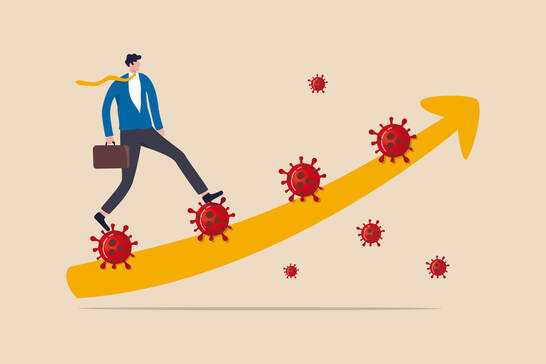
COVID-19 has Reshaped our Economy

In the midst of COVID, the U.S. unemployment rate jumped to 14.7%– the highest level since the Depression era in the 1920s and 1930s. Certain industries were more affected than others: air travel and cruise ship operations were halted, prompting layoffs and bankruptcies in the travel industry. On the other hand, retailers who could seamlessly adapt to the new restrictions, such as by offering reduced-occupancy in-store operations and curbside pickup, were less affected. Industries such as concert venues which rely solely on live, in-person events find themselves struggling to adapt to the “new normal.”
The economic downturn has led to layoffs as many companies strive to remain operational among slimming profit margins. Companies have had to trim their workforce to stay profitable and adapt to changing times to avoid going under. Large tech companies, such asAirBnB,Uber, and evenIBM, announced layoffs in their workforce, along with companies in other industries, likeBoeing. Smaller, lesser known tech companies also underwent layoffs. Toast, a software company making restaurant management tools, cut50% of its approximately 2,000-person workforceamidst closures of restaurants and widespread transitions to carry-out operations, which undercut restaurant operations.
The contagious nature of COVID-19 has created a new blueprint for our economy and has changed how we work and conduct other facets of day-to-day life. In this modified economic environment, the whole economy is down, which means industries across the board are struggling and laying off workers.
Despite the financial upheaval associated with the current pandemic, many tech companies are finding a way to stay economically strong in these tough times and avoid even more layoffs. For the most part, technology has helped people thrive during a time when physical interaction with people could exacerbate the pandemic’s effects. The fact remains, though, that COVID-19 has changed how we live, work, and play.
The Industry-Specific (and Non-Specific) Effects of COVID-19
COVID-19’s effect on specific industries will affect how we think about recruiting. As sectors of the economy are differentially affected, the specific industries that are most affected by COVID-19 may actually be a great source of candidates for your organization.
Certain industries will be more impacted than others. Energy, oil, hospitality, automotive, and service-based industries such as salons and gyms are more impacted than most. While some industries will be able to get back into the swing of things quickly, others will take a while to get back to normal.
Tech is one industry that has burgeoned during this difficult time. Theinformation technologysector of the stock market has grown 34.8% over the last year, which makes it the most successful sector in the economy this year, outperforming the S&P 500 by approximately threefold, according toFidelity. Tech companies are adapting, their products and services are more in demand, and, despite necessary layoffs, the tech sector is outperforming other sectors during the recession.
The economic downturn can be a great opportunity to build a pipeline of potential employees for your organization. People in an industry that is struggling during the present economic situation will likely be looking to switch industries. As many tech companies are thriving in the current environment, people who are laid off from other industries – or within the industry – may seek to gain work in this important and flourishing sector.
It’s a Great Time to Build up your Pipeline
During a period of high unemployment, companies should continue building their pipeline – looking for people to hire for whenever hiring is unfrozen. Candidates can come from a different industry – including a “dying” industry – but still have relevant skills that overlap with your company’s goals and mission.
There’s no need to wait until the economy is better to build up your pipeline of qualified candidates. Even if your organization is not hiring right now, you should continue identifying roles that may need to be filled and developing a pipeline of qualified candidates. No matter what the unemployment landscape is, it will always be challenging to find the right candidates with the necessary skills and experience needed to drive your organization forward. That’s why it is essential to build your pipeline and ensure that there are candidates in your recruitment funnel so that, when you do restart hiring, your time to hire is as short as possible.
It’s easy to find candidates who are likely qualified.Quality candidate datacan help you target qualified, interested, and available candidates without having to screen each candidate manually. For example, you can identify companies’ technology stacks and target candidates within companies that use a similar stack to your department’s. Increase likelihood of candidate interest by targeting companies in “dying” industries, as their employees are more likely to be interested in moving to a more stable industry and job. Another way to use data in recruiting is to use companies’ websites and news releases to identify companies who have gone through layoffs and identify qualified candidates from those companies. Not all candidates update their LinkedIn profiles in the event of a layoff or job change, and some don’t rely on LinkedIn for networking and career advancement, so alternative data sources can be a great help to build the candidate pipeline in economically unpredictable times like these.
Conclusion
While COVID-19 has all but upended the global economy, it has also made conditions favorable for recruitment of new hires. With all the economic uncertainty and record-breaking layoffs and furloughs, people may be open to transition to a new industry less impacted by the current conditions, or are simply looking for a stable job to help them get back on their feet. Building a strong candidate pipeline is important to help find prospective hires in times like these when people are more willing to take a chance on a new job opportunity.
Building such a pipeline of qualified candidates is a win-win – candidates who are in a struggling industry or already laid off are likely already looking for new opportunities – and, while it may not be readily apparent, they may have the right skills for your organization.
Even though times may be unpredictable, it’s a great time to build your pipeline and look for qualified, interested, and available candidates. Websites, news releases, and other data such as technology stacks of competing companies, can all be used to perform data-driven recruiting. When candidates from other industries are recruited that may be out of a job or are looking to transition to a more stable industry, the result is a win-win.




Leave a Reply